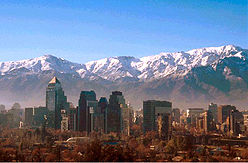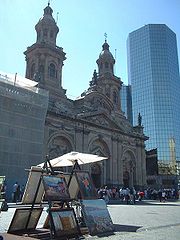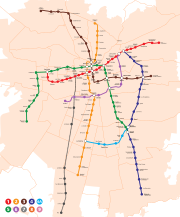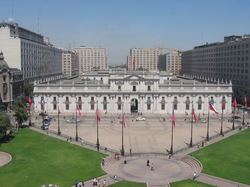Santiago, Chile
From Wikipedia, the free encyclopedia
| Santiago, Chile Santiago de Chile |
|||
| The snowcapped Andes above Santiago's financial district | |||
|
|||
| Location of Santiago commune in Greater Santiago | |||
| Coordinates: | |||
|---|---|---|---|
| Region | Santiago Metropolitan Region | ||
| Province | Santiago Province | ||
| Foundation | February 12, 1541 | ||
| Government | |||
| - Mayor | Raúl Alcaíno Lihn | ||
| Area 1 | |||
| - City | 22.4 km² (8.6 sq mi) | ||
| - Urban | 641.4 km² (247.6 sq mi) | ||
| Elevation | 520 m (1,706 ft) | ||
| Population (2002)² | |||
| - City | 200,792 | ||
| - Density | 8,464/km² (3,267/sq mi) | ||
| - Urban | 5,428,590 | ||
| - Metro | 6,402,552 | ||
| Time zone | Chile Time (CLT)[1] (UTC-4) | ||
| - Summer (DST) | Chile Summer Time (CLST)[2] (UTC-3) | ||
| 1 City = Santiago Centro, Urban = Greater Santiago | |||
| Website: municipalidaddesantiago.cl | |||
Santiago (Spanish: Santiago de Chile (help·info)), is the capital of Chile, and the center of its largest conurbation (Greater Santiago). It is situated at an elevation of 520 m (1700 ft) in the country's central valley. Although Santiago is the capital, legislative bodies meet in nearby Valparaíso.
Approximately two decades of uninterrupted economic growth have transformed Santiago into one of Latin America's most sophisticated metropolitan areas, with extensive suburban development, dozens of shopping malls, and impressive high-rise architecture. The city also boasts some of Latin America's most spectacular infrastructure, such as the Santiago Metro and the sparkling new Costanera Norte, a highway system that passes below downtown and connects the Eastern and Western extremes of the city in a 40-minute drive. Santiago is headquarters to many important companies and is a regional financial center.
Contents |
[edit] Note

Throughout this article the term Santiago will normally refer to the Greater Santiago area; however, there are several other entities which bear the name of Santiago and need to be explained: The commune (comuna) of Santiago (sometimes referred to as Santiago Centro), is a subdivision of the Santiago Province, which is itself a subdivision of the Santiago Metropolitan Region. The commune is administered by the Santiago municipality (Municipalidad de Santiago), a separate legal entity with an elected mayor and council. It encompasses the oldest part of Greater Santiago, including downtown, and houses all major government infrastructure, including the government palace La Moneda. It has an area of 22.4 km² (9 sq mi) and a population of 200,792 (2002 census).
[edit] History

Santiago was founded by Pedro de Valdivia on February 12, 1541 with the name Santiago de Nueva Extremadura. The founding ceremony was held on Huelén Hill (later renamed Cerro Santa Lucía). Valdivia chose the location of Santiago because of its moderate climate and the ease with which it could be defended—the Mapocho River splits into two branches and rejoins further downstream, forming an island.
The city was destroyed on September 11, 1541 by the Indian forces under the chief Michimalonco, which led to the Arauco War.
The first buildings were erected with the help of the native Picunche Indians. The south bank of the Mapocho River was later drained and converted into a public promenade, known as the Alameda (now Avenida Alameda Libertador Bernardo O'Higgins). The city was slightly damaged during the War of Independence (1810–18), in the Battle of Maipú, which was fought south-west of the city. Santiago was named capital in 1818.

During the early 19th century, Santiago remained a small town with few buildings excepting Palacio de La Moneda, the building used as the Chilean mint during the Spanish period, and a few churches and other civic buildings. The Iglesia de la Compañía de Jesús caught fire during an 1863 church service, and 2000 people died, one of the worst modern fires.[3]
In the 1880s extraction of nitrate fertilizer in Northern Chile brought prosperity to the country, and promoted the capital city's development. Important landmarks were built in 1910 during the Centennial celebrations of independence from Spain, such as the National Library, the Museum of Fine Arts and the Mapocho Train Station (Estación Mapocho, now an events center)..
Santiago began its transformation into a modern city in the 1930s, with the building of the Barrio Cívico, surrounding El Palacio de La Moneda. The city also grew in population, due to migration from the north and south of Chile. In 1985 an earthquake destroyed some historically significant buildings in the downtown area.
Nowadays, Santiago is among the largest and most important financial centers in Latin America, ranking high as a Global City.
[edit] Geography
The city lies in the center of the Santiago Basin, an enormous bowl-shaped valley consisting of a broad and fertile plain surrounded by mountains. It is flanked by the main chain of the Andes on the east and the Chilean Coastal Range on the west. On the north is bounded by the Cordón de Chacabuco, a transverse mountain range of the Andes, whereas at the southern border lies Angostura de Paine, a valley narrowing where an elongated spur of the Andes almost reaches the Coastal Range. Santiago Basin is part of the Intermediate Depression and is remarkably flat, interrupted only by a few hills. Among those are Cerro Renca, Cerro Blanco and Cerro Santa Lucía.
The Andes de Santiago are a massive mountainous system culminating in Tupungato volcano at 6,570 m (21,555 ft). Other volcanoes include Tupungatito, San José and Maipo. Cerro El Plomo is the highest mountain visible from Santiago urban area.
[edit] Climate
Santiago has a mild Mediterranean climate: relatively hot dry summers (November to March) with temperatures reaching up to 35 degrees Celsius (95 degrees Fahrenheit) on the hottest days; winters (June to August) are more humid, with typical maximum daily temperatures of 15 degrees Celsius (59 degrees Fahrenheit), and minimums of a few degrees above freezing. Occasional snowfall occurs on higher suburbs of the city. Mean rainfall is 338 mm per year.
| Weather averages for Santiago, Chile | |||||||||||||
|---|---|---|---|---|---|---|---|---|---|---|---|---|---|
| Month | Jan | Feb | Mar | Apr | May | Jun | Jul | Aug | Sep | Oct | Nov | Dec | |
| Average high °C (°F) | 29.7 (85) | 29.1 (84) | 26.9 (80) | 23.3 (74) | 18.7 (66) | 15.2 (59) | 14.9 (59) | 16.7 (62) | 19.0 (66) | 22.3 (72) | 25.4 (78) | 28.4 (83) | |
| Average low °C (°F) | 13.0 (55) | 12.4 (54) | 10.7 (51) | 8.0 (46) | 6.3 (43) | 4.3 (40) | 3.9 (39) | 4.8 (41) | 6.1 (43) | 8.2 (47) | 10.1 (50) | 12.0 (54) | |
| Precipitation mm (inch) | 0.4 (0) | 0.8 (0) | 3.2 (0.1) | 10.4 (0.4) | 42.2 (1.7) | 70.4 (2.8) | 86.6 (3.4) | 51.8 (2) | 22.0 (0.9) | 13.4 (0.5) | 9.2 (0.4) | 2.1 (0.1) | |
| Source: worldweather.org 04 September, 2007 | |||||||||||||
Thermal inversion (a meteorological phenomenon whereby a stable layer of warm air holds down colder air close to the ground) causes high levels of smog and air pollution to be trapped and concentrate within the Central Valley during winter months. In the 1990s air pollution fell by about one-third, but there has been little progress since 2000.
The Mapocho river, which crosses the city from the north-east to the south-west of the Central Valley, is contaminated by industrial and household sewage, dumped unfiltered into the river, and by upstream copper-mining waste (there are a number of copper mines in the Andes east of Santiago). The central government recently passed a law that forces industry and local governments to process all their wastewater by 2006. There are now a number of large wastewater processing and recycling plants under construction. There are ongoing plans to decontaminate the river and make it navigable.
Sound levels on the main streets are high, mostly because of noisy diesel buses. Diesel trucks and buses are also major contributors to winter smog. A lengthy replacement process of the bus system began in 2005 and will last until 2010 (see Transportation section below).
[edit] Demographics
The population of Santiago's urban agglomeration grew from 0.982 million in 1940 to 2.82 million in 1970 and 4.75 million in 1992. According to the 2002 census, it contains a population of about 5.47 million, equivalent to nearly 37% of the total population of the country and 43% of the total urban population, making it one of the largest cities in Latin America. Santiago's Metropolitan Area, according to an official estimate from 2006, has a population of 6.293 million people.
The city is increasingly receiving immigration from other countries in Latin America due to comparatively strong economic growth. Many Peruvians live in Santiago, as well as Bolivians, Argentines, and Ecuadorians.
[edit] Economy
Santiago is the industrial and financial center of Chile, and generates 45 percent of the country's GDP. The city, along with Buenos Aires and São Paulo, is one of the main financial centres of South America. Some international institutions, such as ECLAC (Economic Commission for Latin America and the Caribbean), have their offices in Santiago.
In recent years, due to the strong growth and stability of the Chilean economy, many multinational companies have chosen Santiago as the place for their headquarters in the region, like HP, Reuters, JP Morgan, Intel, Coca-Cola, Unilever, Nestlé, Kodak, BHP Billiton, IBM, Motorola, Microsoft, Ford, Yahoo!, and many more.
[edit] Construction

The construction sector is booming in Santiago. Several large apartment complexes are being built throughout the city and construction cranes are a common sight. Currently under construction is the Costanera Center, a mega project in Santiago's Financial District. This includes a 280,000 square metre (3,014,000 sq ft) mall, a 300 metre (980 ft) tower, two office towers of 170 metres (558 ft) each, and a hotel 105 metres (344 ft) tall. When completed in 2010 it will be the tallest building in South America. Near Costanera Center another skyscraper is being built, Titanium La Portada, and this will be 190 metres (623 ft) tall. Although these are the two biggest projects, there are many other office buildings under construction in Santiago, as well as hundreds of high rise residential buildings.
[edit] Transport
[edit] Air
Arturo Merino Benítez International Airport is Santiago's national and international airport.
[edit] Rail
Trains operated by Chile's national railway, Empresa de los Ferrocarriles del Estado, connect Santiago to Temuco, in the central-southern part of the country. All such trains arrive and depart from the Estación Central ("Central Station").
[edit] Buses
Bus companies provide passenger transportation from Santiago to most areas of the country, while some also provide parcel-shipping and delivery services.
[edit] Highways

Toll road, inter-urban free flow highways connect the city's extremes, including the Vespucio Highway (which surrounds the city describing a semi-circle), Autopista Central (which crosses the city in a North-South direction), and the Costanera Norte (which runs from the eastern edge, in Las Condes to the international airport and the higways to Valparaíso on the western side of the city).
[edit] Metro
The Santiago Metro has five operating lines but their coverage is still somewhat limited. Two subway lines (Line 4 and 4A) and an extension of Line 2 were inaugurated during late 2005 and 2006. The system is under expansion, and extensions are going to be built on Lines 1 and 5 throughout 2009.
[edit] Transantiago
Transantiago is the name for the city's public transport system. It was introduced on February 10, 2007, replacing the previous chaotic system run by thousands of independent bus operators. The system works by combining local bus lines, main bus lines and the metro network. It includes an integrated fare system, which allows passengers to make bus-to-bus or bus-to-metro transfers for the price of one ticket, using a single contactless smartcard.
The new system has had an extremely rocky beginning, attracting all manner of criticisms from the public and the media, the main ones being that the network is not extensive enough, and that there simply aren't enough buses to serve the volume of people concerned. The effect of the change has led to several riots and public displays of outrage by frustrated passengers, and has generated turmoil throughout the governmment.
[edit] Taxi
Taxicabs can usually be found on the streets and are painted black with yellow roofs; unmarked taxis may be called up by telephone (Radiotaxis). Colectivos are shared taxicabs that carry passengers along a specific route, for a fixed fee.
[edit] Political divisions
Greater Santiago extends throughout 37 municipalities and covered 64,140 ha in 2002. The majority of Santiago lies within the same named province, with some peripheral areas contained in the provinces of Talagante, Maipo and Cordillera. Specifically, Santiago joins the cities of San Bernardo (Maipo province) and Puente Alto (Cordillera province) to form the Greater Santiago conurbation.
The province of Santiago is divided into 32 municipalities (comunas in Spanish). Each municipality in Chile is headed by a mayor (alcalde) elected by voters every four years. The members of the municipal council (concejales) are elected in the same election on a separate ballot.
[edit] Cultural life
[edit] Music
There are two symphonic orchestras:
- Orquesta Filarmónica de Santiago, which performs in the Teatro Municipal
- Orquesta Sinfónica de Chile, dependent of the Universidad de Chile, performs in its theater.
There are also various jazz establishments, the most notable being the Club de Jazz in Ñuñoa.
[edit] Museums
Museums include:
- Centro Cultural Palacio de La Moneda, newest and biggest cultural space, beneath the Citizenry Square, in the south front of the government palace La Moneda
- Museo Arqueológico de Santiago
- Museo de Santiago Casa Colorada
- Museo Catedral Metropolitana
- Museo Colonial San Francisco
- Museo Chileno de Arte Precolombino
- Museo Histórico Nacional
- Museo Nacional de Bellas Artes
- Museo de Arte Contemporáneo
- Museo Interactivo Mirador
- Museo Artequín
- Museo de Ciencia y Tecnología
- Museo Ferroviario
- Museo de la Solidaridad "Salvador Allende"
- Palacio Cousiño
- La Chascona, Pablo Neruda's house, now a museum
[edit] Recreation
The city's main parks are:
- San Cristóbal Hill (Cerro San Cristóbal), which includes the Santiago Metropolitan Park Zoo
- O'Higgins Park (Parque O'Higgins)
- Forestal Park (Parque Forestal), park located at the city centre alongside Mapocho river
- Cerro Santa Lucía
Modern ski resorts within an hour's drive east from the city include:
- Farellones
- Valle Nevado
- La Parva
- Portillo is about three hours away.
Some of the country's most important winegrowing areas lie in the nearby Maipo and Aconcagua Valleys. Several vineyards are located in this area:
Cultural places to visit include:
- Museo de Bellas Artes
- Barrio Bellavista, cultural and bohemian neighborhood
- Central Station, railway station designed by Gustave Eiffel
- Víctor Jara Stadium
- Ex National Congress
- Plaza de Armas, downtown square
- Palacio de La Moneda, government palace
Main Sport Venues:
- Estadio Nacional (site of the 1962 World Cup final) 65.000 all-seated
- Estadio Monumental David Arellano 62.000 all-seated
- Estadio Santa Laura 28.500 all-seated
- Estadio San Carlos de Apoquindo 20.000 all-seated
[edit] Religion

Most of Chile's population is Catholic and Santiago is no exception. According to the National Census, carried out in 2002 by the National Statistics Bureau (INE), in the Santiago Metropolitan Region, 3,129,249 people 15 and older identified themselves as Catholics, equivalent to 68.7% of the total population, while 595,173 (13.1%) described themselves as Evangelical Protestants. Around 1.2% of the population declared to be Jehovah's Witnesses, while 0.9% identified themselves as Latter-day Saints (Mormons), 0.25 as Jewish, 0.03 as Muslims and 0.11 as Orthodoxs. Approximately 10.4% of the population of the Metropolitan Region stated that they were atheist or agnostic, while 5.4% declared to follow other religions.
Source: INE, Chile, 2002 Census [1]
[edit] Universities
[edit] Traditional
- Pontificia Universidad Católica de Chile (Puc)
- Universidad de Chile (U, UCh) Oldest and leading institution
- Universidad de Santiago de Chile (Usach)
- Universidad Metropolitana de Ciencias de la Educación (Umce)
- Universidad Tecnológica Metropolitana (Utem)
[edit] Non-Traditional
- Postgraduierten- und Weiterbildungszentrum der Universität Heidelberg (Ruprecht Karl University of Heidelberg) in Santiago de Chile
- Universidad Academia de Humanismo Cristiano
- Universidad Adolfo Ibáñez (UAI)
- Universidad Alberto Hurtado
- Universidad Bernardo O'Higgins
- Universidad Bolivariana
- Universidad Católica Raúl Silva Henríquez
- Universidad Central de Chile
- Universidad de Artes y Ciencias Sociales (Arcis)
- Universidad de Artes, Ciencias y Comunicación (UNIACC)
- Universidad de Ciencias de la Informática
- Universidad de las Américas
- Universidad de Los Andes
- Universidad del Desarrollo
- Universidad del Pacífico
- Universidad Diego Portales
- Universidad Europea de Negocios
- Universidad Finis Terrae
- Universidad Gabriela Mistral
- Universidad Iberoamericana de Ciencias y Tecnología
- Universidad Internacional SEK
- Universidad La República
- Universidad Mariano Egaña
- Universidad Mayor
- Universidad Miguel de Cervantes
- Universidad Nacional Andrés Bello
- Universidad Santo Tomás
- Universidad Tecnológica Vicente Pérez Rosales
[edit] References
- ^ Chile Time. World Time Zones .org. Retrieved on 2007-05-05.
- ^ Chile Summer Time. World Time Zones .org. Retrieved on 2007-05-05.
- ^ Brief report of the fire (Spanish)
[edit] External links
- Municipality homepage
- Independent City Guide to Santiago, Chile
- Santiago de Chile Daily Photo - A new photograph of Santiago every day.
- A cultural and historical neighborhood, to visit in Santiago
|
|
|---|
|
Asunción, Paraguay · Bogotá, Colombia · Brasília, Brazil · Buenos Aires, Argentina · Caracas, Venezuela · Cayenne, French Guiana · Georgetown, Guyana · Grytviken, South Georgia and the South Sandwich Islands · La Paz, Bolivia · Lima, Peru · Montevideo, Uruguay · Paramaribo, Suriname · Quito, Ecuador · Santiago, Chile · Sucre, Bolivia · Stanley, Falkland Islands Valparaíso, Chile · |




















